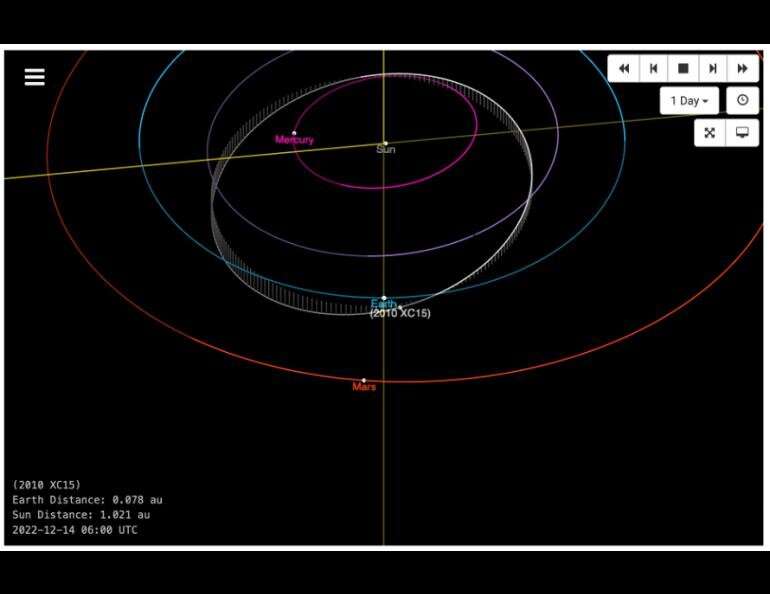Research site will bounce radio signal off asteroid in NASA experiment

An experiment to bounce a radio signal off an asteroid on Dec. 27 will serve as a test for probing a larger asteroid that in 2029 will pass closer to Earth than the many geostationary satellites that orbit our planet.
The High-frequency Active Auroral Research Program research site in Gakona will transmit radio signals to asteroid 2010 XC15, which could be about 500 feet across. The University of New Mexico Long Wavelength Array near Socorro, New Mexico, and the Owens Valley Radio Observatory Long Wavelength Array near Bishop, California, will receive the signal.
This will be the first use of HAARP to probe an asteroid.
"What's new and what we are trying to do is probe asteroid interiors with long wavelength radars and radio telescopes from the ground," said Mark Haynes, lead investigator on the project and a radar systems engineer at NASA's Jet Propulsion Laboratory in Southern California. "Longer wavelengths can penetrate the interior of an object much better than the radio wavelengths used for communication."
Knowing more about an asteroid's interior, especially of an asteroid large enough to cause major damage on Earth, is important for determining how to defend against it.
"If you know the distribution of mass, you can make an impactor more effective, because you'll know where to hit the asteroid a little better," Haynes said.
Many programs exist to quickly detect asteroids, determine their orbit and shape and image their surface, either with optical telescopes or the planetary radar of the Deep Space Network, NASA's network of large and highly senstive radio antennas in California, Spain and Australia.
Those radar-imaging programs use signals of short wavelengths, which bounce off the surface and provide high-quality external images but don't penetrate an object.
HAARP will transmit a continually chirping signal to asteroid 2010 XC15 at slightly above and below 9.6 megahertz (9.6 million times per second). The chirp will repeat at two-second intervals. Distance will be a challenge, Haynes said, because the asteroid will be twice as far from Earth as the moon is.
The University of Alaska Fairbanks operates HAARP under an agreement with the Air Force, which developed and owned HAARP but transferred the research instruments to UAF in August 2015.
The test on 2010 XC15 is yet another step toward the globally anticipated 2029 encounter with asteroid Apophis. It follows tests in January and October in which the moon was the target of a HAARP signal bounce.
Apophis was discovered in 2004 and will make its closest approach to Earth on April 13, 2029, when it comes within 20,000 miles. Geostationary satellites orbit Earth at about 23,000 miles. The asteroid, which NASA estimated to be about 1,100 feet across, was initially thought to pose a risk to Earth in 2068, but its orbit has since been better projected by researchers.
The test on 2010 XC15 and the 2029 Apophis encounter are of general interest to scientists who study near-Earth objects. But planetary defense is also a key research driver.
"The more time there is before a potential impact, the more options there are to try to deflect it," Haynes said.
NASA says an automobile-sized asteroid hits Earth's atmosphere about once a year, creating a fireball and burning up before reaching the surface.
About every 2,000 years a meteoroid the size of a football field hits Earth. Those can cause a lot of damage. And as for wiping out civilization, NASA says an object large enough to do that strikes the planet once every few million years.
NASA first successfully redirected an asteroid on Sept. 26, when its Double Asteroid Redirection Test mission, or DART, collided with Dimorphos. That asteroid is an orbiting moonlet of the larger Didymos asteroid.
The DART collision altered the moonlet's orbit time by 32 minutes.
The Dec. 27 test could reveal great potential for the use of asteroid sensing by long wavelength radio signals. Approximately 80 known near-Earth asteroids passed between the moon and Earth in 2019, most of them small and discovered near closest approach.
"If we can get the ground-based systems up and running, then that will give us a lot of chances to try to do interior sensing of these objects," Haynes said.
"HAARP is excited to partner with NASA and JPL to advance our knowledge of near-Earth objects," said Jessica Matthews, HAARP's program manager.
Provided by University of Alaska Fairbanks



















